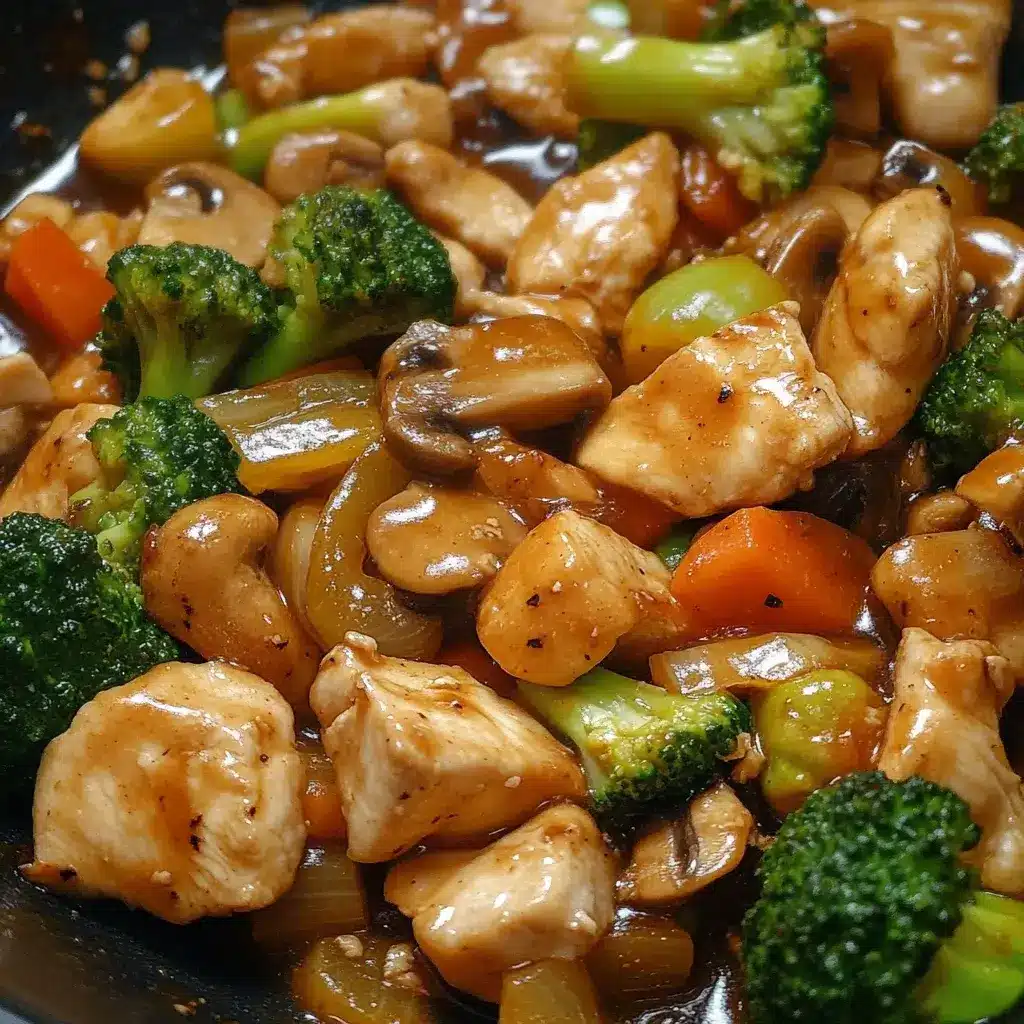This Chicken and Veggie Stir Fry recipe has become an absolute staple in my kitchen, a true weeknight warrior that never fails to impress. I remember the first time I made it – I was short on time, staring into a fridge full of assorted vegetables and some chicken breasts, wondering how to turn it into something exciting. Skepticism turned into delight as the aroma filled the kitchen, a tantalizing blend of savory soy sauce, sharp ginger, and garlic. My family, usually discerning critics, devoured it. The crisp-tender vegetables, the juicy chicken, all coated in that perfectly balanced sauce – it was an instant hit! Since then, it’s been my go-to for a quick, healthy, and incredibly satisfying meal. It’s endlessly adaptable, forgiving for beginner cooks, and delivers restaurant-quality flavor right at home. It’s more than just food; it’s the comforting, delicious answer to the perennial “what’s for dinner?” question, proving that healthy eating can be vibrant, fast, and something the whole family genuinely looks forward to. This recipe isn’t just about sustenance; it’s about creating moments of shared enjoyment around a simple, yet spectacular, homemade dish.
Ingredient
Here’s what you’ll need to create this vibrant and flavorful Chicken and Veggie Stir Fry. We’ve broken it down into components for clarity:
For the Chicken & Marinade:
- 1.5 lbs (about 680g) Boneless, Skinless Chicken Breasts: Cut into uniform, bite-sized pieces (about 1-inch cubes) for even cooking. You can also use boneless, skinless chicken thighs for extra flavor and moisture.
- 1 Tablespoon Soy Sauce (or Tamari for Gluten-Free): Adds savory depth and helps tenderize the chicken. Use low-sodium if preferred.
- 1 Teaspoon Cornstarch: Creates a light coating on the chicken, helping it brown nicely and thicken the sauce slightly later.
- 1 Teaspoon Toasted Sesame Oil: Imparts a distinct nutty aroma and flavor essential to many Asian dishes.
- ½ Teaspoon Black Pepper: Freshly ground offers the best flavor.
For the Stir Fry Sauce:
- ½ Cup Low-Sodium Chicken Broth (or Vegetable Broth): Forms the base of the sauce, adding liquid and flavor.
- ¼ Cup Low-Sodium Soy Sauce (or Tamari for Gluten-Free): The primary savory and umami component of the sauce.
- 2 Tablespoons Honey (or Maple Syrup or Brown Sugar): Adds a touch of sweetness to balance the savory notes. Adjust to your preference.
- 1 Tablespoon Rice Vinegar: Provides a gentle tanginess that brightens the sauce. Apple cider vinegar can be a substitute in a pinch.
- 1 Tablespoon Cornstarch: The key thickening agent for the sauce. Mix it well to avoid lumps.
- 1 Teaspoon Toasted Sesame Oil: Reinforces the nutty flavor profile.
- ½ Teaspoon Red Pepper Flakes (Optional): Add for a touch of heat. Adjust the amount based on your spice tolerance.
For the Stir Fry Vegetables & Aromatics:
- 2 Tablespoons High-Heat Cooking Oil: Such as avocado oil, canola oil, grapeseed oil, or peanut oil, divided. Needed for sautéing without burning.
- 1 Large Yellow Onion: Thinly sliced or roughly chopped, providing a foundational aromatic flavor.
- 3-4 Cloves Garlic: Minced or finely grated. A crucial aromatic base.
- 1 Tablespoon Fresh Ginger: Minced or finely grated. Adds a warm, zesty spice.
- 1 Large Head of Broccoli: Cut into small, bite-sized florets (about 3-4 cups). Ensure pieces are similar in size for even cooking.
- 1 Large Red Bell Pepper: Seeded and thinly sliced or cut into 1-inch pieces. Adds sweetness and vibrant color.
- 1 Large Carrot: Peeled and thinly sliced on the diagonal (julienned also works). Provides crunch and sweetness.
- ½ Cup Snap Peas or Snow Peas: Trimmed. Offer a delightful crispness and fresh green flavor.
- Optional additions: Sliced mushrooms (cremini or shiitake), chopped baby corn, water chestnuts, sliced zucchini, or bok choy stems. Aim for about 6-8 cups of chopped vegetables in total.
For Garnish (Optional):
- Toasted Sesame Seeds: Add a nutty crunch and visual appeal.
- Sliced Green Onions (Scallions): Both green and white parts, adding a fresh, mild onion flavor.
- Chopped Fresh Cilantro: For those who enjoy its bright, herbaceous notes.
Instructions
Follow these steps carefully for a perfectly cooked Chicken and Veggie Stir Fry every time. Preparation (mise en place) is key!
- Prepare the Chicken: Pat the chicken pieces dry with paper towels; this helps them brown better. In a medium bowl, combine the chicken pieces, 1 tablespoon soy sauce (or tamari), 1 teaspoon cornstarch, 1 teaspoon toasted sesame oil, and ½ teaspoon black pepper. Toss well to coat evenly. Let the chicken marinate for at least 15-20 minutes at room temperature while you prepare the vegetables and sauce. For deeper flavor, you can marinate it covered in the refrigerator for up to an hour.
- Prepare the Vegetables and Aromatics: Wash and chop all your chosen vegetables (broccoli, bell pepper, carrot, snap peas, onion, etc.) into bite-sized, relatively uniform pieces. This ensures they cook evenly and quickly. Mince or grate the garlic and ginger. Set everything aside in separate bowls or piles on a large cutting board – having everything ready (mise en place) is crucial for stir-frying.
- Make the Stir Fry Sauce: In a small bowl or liquid measuring cup, whisk together the chicken broth, ¼ cup soy sauce (or tamari), honey (or chosen sweetener), rice vinegar, 1 tablespoon cornstarch, 1 teaspoon toasted sesame oil, and optional red pepper flakes. Ensure the cornstarch is fully dissolved to prevent lumps in the sauce. Set aside.
- Cook the Chicken: Heat 1 tablespoon of the high-heat cooking oil in a large skillet or wok over medium-high heat. The pan should be hot enough that a drop of water evaporates instantly. Add the marinated chicken in a single layer, being careful not to overcrowd the pan (cook in batches if necessary). Let the chicken cook undisturbed for 2-3 minutes per side, until golden brown and cooked through. Use tongs or a spatula to turn the pieces. Once cooked, remove the chicken from the skillet/wok and set it aside on a clean plate.
- Sauté Aromatics: Add the remaining 1 tablespoon of oil to the same skillet/wok over medium-high heat. Add the sliced onion and cook for 2-3 minutes, stirring frequently, until it starts to soften and become translucent.
- Cook Harder Vegetables: Add the firmer vegetables like carrots and broccoli florets to the skillet. Stir-fry for 3-4 minutes, tossing frequently. Add a tablespoon or two of water or chicken broth if the pan seems too dry or the vegetables start to stick; the steam helps cook them through while maintaining crispness.
- Add Softer Vegetables and Aromatics: Add the softer vegetables like bell peppers and snap peas (or snow peas), along with the minced garlic and grated ginger. Stir-fry for another 2-3 minutes. You want the vegetables to be crisp-tender – brightly colored and slightly softened but still retaining a pleasant bite. Avoid overcooking, which leads to soggy vegetables.
- Combine and Sauce: Return the cooked chicken to the skillet/wok with the vegetables. Give the prepared stir fry sauce a quick whisk (as the cornstarch may have settled) and pour it over the chicken and vegetables.
- Thicken the Sauce: Bring the mixture to a simmer, stirring constantly. Cook for 1-2 minutes, or until the sauce has thickened to your desired consistency, coating the chicken and vegetables nicely. The heat activates the cornstarch, creating a glossy sauce.
- Serve: Remove the skillet/wok from the heat immediately once the sauce has thickened to prevent overcooking. Taste and adjust seasoning if necessary (more soy sauce for saltiness, honey for sweetness, or vinegar for tang). Serve the Chicken and Veggie Stir Fry hot.
Nutrition Facts
This information is an estimate and can vary based on specific ingredients and portion sizes used.
- Servings: Approximately 4 servings
- Calories per Serving: Approximately 450-550 kcal (depending heavily on oil, sweetener, and specific vegetables used)
- Protein: ~40-50g – Crucial for muscle building, repair, and satiety. Chicken breast is a primary source here.
- Fiber: ~6-9g – Important for digestive health and helps you feel full. Derived mainly from the variety of vegetables.
- Sodium: ~800-1200mg – Primarily from soy sauce and broth. Using low-sodium versions helps manage intake. Be mindful if you have dietary sodium restrictions.
- Carbohydrates: ~30-40g – Provides energy. Comes from vegetables, cornstarch, and any sweetener used. Serving with rice or noodles will significantly increase this.
- Fat: ~15-25g – Includes healthy fats from the oil and chicken (especially if using thighs), contributing to flavor and nutrient absorption.
Preparation Time
- Total Time: Approximately 35-45 minutes
- Prep Time: 20-25 minutes (includes marinating time, chopping vegetables, mixing sauce)
- Cook Time: 15-20 minutes
This timing makes it an excellent choice for a relatively quick and efficient weeknight meal, especially if you prep some vegetables ahead of time.
How to Serve
This Chicken and Veggie Stir Fry is wonderfully versatile. Here are some serving suggestions:
- Over Rice:
- Serve hot over a bed of fluffy steamed white rice (like Jasmine or Basmati) to soak up the delicious sauce.
- For a healthier option, use brown rice or quinoa, which adds extra fiber and nutrients.
- Cauliflower rice is an excellent low-carb alternative.
- With Noodles:
- Toss the stir fry with cooked noodles such as ramen, udon, soba, or even spaghetti for a hearty meal.
- Rice noodles offer a great gluten-free option.
- As a Standalone Dish:
- Enjoy it on its own for a lower-carb, protein-packed meal. The abundance of vegetables makes it quite filling.
- Garnishes:
- Sprinkle generously with toasted sesame seeds for added texture and nutty flavor.
- Top with thinly sliced green onions (scallions) for a fresh, sharp bite.
- Add chopped fresh cilantro for a burst of herbaceous freshness (if you enjoy its flavor).
- A drizzle of Sriracha or a pinch more red pepper flakes can be added for extra heat.
- Side Dishes (Optional):
- Serve alongside simple Asian-inspired sides like cucumber salad, steamed edamame, or spring rolls.
Additional Tips
Unlock the full potential of your Chicken and Veggie Stir Fry with these expert tips:
- Mise en Place is Non-Negotiable: Stir-frying happens quickly over high heat. Have all your ingredients (chopped vegetables, measured sauce components, cooked chicken) ready and within arm’s reach before you turn on the stove. There’s no time to chop once cooking begins.
- Use High Heat and the Right Pan: A wok is ideal because its shape allows for easy tossing and concentrated heat at the bottom. If you don’t have a wok, use the largest, heaviest skillet you own (cast iron works well). Ensure the pan is properly preheated – the oil should shimmer, and ingredients should sizzle immediately upon contact. High heat is crucial for achieving that characteristic “wok hei” flavor and preventing soggy vegetables.
- Don’t Crowd the Pan: Cooking too many ingredients at once lowers the pan’s temperature, leading to steaming instead of searing. Cook the chicken and vegetables in batches if necessary to ensure everything gets properly browned and cooked quickly. This maintains texture and flavor.
- Cut Ingredients Uniformly: Chop your chicken and vegetables into similar-sized pieces. This ensures they cook evenly in the short time they’re in the hot pan. Smaller pieces cook faster.
- Control the Sauce Consistency: If your sauce is too thin, let it simmer a minute longer to reduce or mix a tiny bit more cornstarch with cold water (a slurry) and whisk it in. If it’s too thick, thin it with a splash of chicken broth or water. Remember the sauce will thicken slightly as it cools.
- Customize Your Veggies: This recipe is incredibly versatile. Feel free to swap or add vegetables based on what’s in season or what you have on hand. Mushrooms, zucchini, baby corn, water chestnuts, bell peppers of different colors, snow peas, sugar snap peas, bok choy (add leaves near the end), asparagus, or green beans are all excellent choices. Just be mindful of cooking times – add harder veggies first.
- Velveting the Chicken (Optional Advanced Step): For exceptionally tender chicken, try a technique called velveting. After step 1 (marinating), you can briefly blanch the chicken pieces in simmering water or oil until they just turn opaque, then drain well before stir-frying as directed in step 4. This creates a silky texture. The cornstarch in the marinade already provides a basic form of this.
- Toast Your Sesame Seeds and Oil: Using toasted sesame oil provides a much deeper, nuttier flavor than regular sesame oil. Similarly, lightly toasting sesame seeds in a dry pan for a few minutes until fragrant enhances their flavor significantly before using them as a garnish.
FAQ
Here are answers to some frequently asked questions about making Chicken and Veggie Stir Fry:
- Q: Can I use a different protein besides chicken breast?
- A: Absolutely! Boneless, skinless chicken thighs are a great substitute, offering more flavor and moisture. Thinly sliced beef (like flank steak or sirloin), pork tenderloin, shrimp, or firm tofu (pressed and cubed) also work wonderfully. Adjust cooking times accordingly – shrimp cooks very quickly, while beef might require high heat searing in batches. For tofu, pan-frying it first until golden helps it hold its shape.
- Q: What are the best vegetables for stir fry?
- A: The best vegetables are those that hold up well to high heat and quick cooking. Excellent choices include broccoli, bell peppers (any color), carrots, onions, snap peas, snow peas, mushrooms (shiitake, cremini), zucchini, baby corn, water chestnuts, and bok choy (stems first, leaves later). Aim for a variety of colors and textures.
- Q: How can I make this recipe gluten-free?
- A: It’s very easy! Simply replace the regular soy sauce with gluten-free tamari or coconut aminos in both the chicken marinade and the stir fry sauce. Ensure your chicken broth is also certified gluten-free. Cornstarch is naturally gluten-free, so no change is needed there.
- Q: Why did my stir fry turn out soggy?
- A: Sogginess usually happens for a few reasons: overcrowding the pan (which lowers heat and causes steaming), not using high enough heat, or overcooking the vegetables. Ensure your pan is very hot, cook in batches if needed, and stir-fry quickly, removing vegetables when they are crisp-tender, not fully soft. Also, make sure your vegetables are relatively dry before adding them to the hot oil.
- Q: Can I make this stir fry ahead of time?
- A: While stir-fries are best enjoyed fresh to maintain the crisp texture of the vegetables, you can do some prep work ahead. Chop all vegetables, mix the sauce ingredients (store separately), and marinate the chicken up to a day in advance, keeping everything refrigerated. This makes assembly much faster when you’re ready to cook. Leftovers can be stored, but the vegetables will soften upon reheating.
- Q: How do I store and reheat leftovers?
- A: Store leftover Chicken and Veggie Stir Fry in an airtight container in the refrigerator for up to 3-4 days. Reheat gently in a skillet over medium heat with a splash of water or broth to prevent drying out, or microwave in short bursts, stirring in between. Avoid overheating, which will make the vegetables mushy.
- Q: Can I use frozen vegetables?
- A: You can, but fresh vegetables generally yield better texture. If using frozen, do not thaw them first. Add them directly to the hot wok/skillet. They will release more water, so ensure your heat is high, and you may need to cook off the excess liquid. You might need to adjust cooking times slightly. A frozen stir-fry vegetable mix can be convenient.
- Q: How can I adjust the spice level?
- A: To make it spicier, increase the amount of red pepper flakes in the sauce, add a pinch of cayenne pepper, or stir in a teaspoon (or more) of Sriracha, chili garlic sauce, or Gochujang into the finished sauce. You could also add sliced fresh chilies (like jalapeño or serrano) along with the aromatics. To make it milder, simply omit the red pepper flakes entirely.

Chicken and Veggie Stir Fry
Ingredients
Here’s what you’ll need to create this vibrant and flavorful Chicken and Veggie Stir Fry. We’ve broken it down into components for clarity:
For the Chicken & Marinade:
- 1.5 lbs (about 680g) Boneless, Skinless Chicken Breasts: Cut into uniform, bite-sized pieces (about 1-inch cubes) for even cooking. You can also use boneless, skinless chicken thighs for extra flavor and moisture.
- 1 Tablespoon Soy Sauce (or Tamari for Gluten-Free): Adds savory depth and helps tenderize the chicken. Use low-sodium if preferred.
- 1 Teaspoon Cornstarch: Creates a light coating on the chicken, helping it brown nicely and thicken the sauce slightly later.
- 1 Teaspoon Toasted Sesame Oil: Imparts a distinct nutty aroma and flavor essential to many Asian dishes.
- ½ Teaspoon Black Pepper: Freshly ground offers the best flavor.
For the Stir Fry Sauce:
- ½ Cup Low-Sodium Chicken Broth (or Vegetable Broth): Forms the base of the sauce, adding liquid and flavor.
- ¼ Cup Low-Sodium Soy Sauce (or Tamari for Gluten-Free): The primary savory and umami component of the sauce.
- 2 Tablespoons Honey (or Maple Syrup or Brown Sugar): Adds a touch of sweetness to balance the savory notes. Adjust to your preference.
- 1 Tablespoon Rice Vinegar: Provides a gentle tanginess that brightens the sauce. Apple cider vinegar can be a substitute in a pinch.
- 1 Tablespoon Cornstarch: The key thickening agent for the sauce. Mix it well to avoid lumps.
- 1 Teaspoon Toasted Sesame Oil: Reinforces the nutty flavor profile.
- ½ Teaspoon Red Pepper Flakes (Optional): Add for a touch of heat. Adjust the amount based on your spice tolerance.
For the Stir Fry Vegetables & Aromatics:
- 2 Tablespoons High-Heat Cooking Oil: Such as avocado oil, canola oil, grapeseed oil, or peanut oil, divided. Needed for sautéing without burning.
- 1 Large Yellow Onion: Thinly sliced or roughly chopped, providing a foundational aromatic flavor.
- 3–4 Cloves Garlic: Minced or finely grated. A crucial aromatic base.
- 1 Tablespoon Fresh Ginger: Minced or finely grated. Adds a warm, zesty spice.
- 1 Large Head of Broccoli: Cut into small, bite-sized florets (about 3–4 cups). Ensure pieces are similar in size for even cooking.
- 1 Large Red Bell Pepper: Seeded and thinly sliced or cut into 1-inch pieces. Adds sweetness and vibrant color.
- 1 Large Carrot: Peeled and thinly sliced on the diagonal (julienned also works). Provides crunch and sweetness.
- ½ Cup Snap Peas or Snow Peas: Trimmed. Offer a delightful crispness and fresh green flavor.
- Optional additions: Sliced mushrooms (cremini or shiitake), chopped baby corn, water chestnuts, sliced zucchini, or bok choy stems. Aim for about 6-8 cups of chopped vegetables in total.
For Garnish (Optional):
- Toasted Sesame Seeds: Add a nutty crunch and visual appeal.
- Sliced Green Onions (Scallions): Both green and white parts, adding a fresh, mild onion flavor.
- Chopped Fresh Cilantro: For those who enjoy its bright, herbaceous notes.
Instructions
Follow these steps carefully for a perfectly cooked Chicken and Veggie Stir Fry every time. Preparation (mise en place) is key!
- Prepare the Chicken: Pat the chicken pieces dry with paper towels; this helps them brown better. In a medium bowl, combine the chicken pieces, 1 tablespoon soy sauce (or tamari), 1 teaspoon cornstarch, 1 teaspoon toasted sesame oil, and ½ teaspoon black pepper. Toss well to coat evenly. Let the chicken marinate for at least 15-20 minutes at room temperature while you prepare the vegetables and sauce. For deeper flavor, you can marinate it covered in the refrigerator for up to an hour.
- Prepare the Vegetables and Aromatics: Wash and chop all your chosen vegetables (broccoli, bell pepper, carrot, snap peas, onion, etc.) into bite-sized, relatively uniform pieces. This ensures they cook evenly and quickly. Mince or grate the garlic and ginger. Set everything aside in separate bowls or piles on a large cutting board – having everything ready (mise en place) is crucial for stir-frying.
- Make the Stir Fry Sauce: In a small bowl or liquid measuring cup, whisk together the chicken broth, ¼ cup soy sauce (or tamari), honey (or chosen sweetener), rice vinegar, 1 tablespoon cornstarch, 1 teaspoon toasted sesame oil, and optional red pepper flakes. Ensure the cornstarch is fully dissolved to prevent lumps in the sauce. Set aside.
- Cook the Chicken: Heat 1 tablespoon of the high-heat cooking oil in a large skillet or wok over medium-high heat. The pan should be hot enough that a drop of water evaporates instantly. Add the marinated chicken in a single layer, being careful not to overcrowd the pan (cook in batches if necessary). Let the chicken cook undisturbed for 2-3 minutes per side, until golden brown and cooked through. Use tongs or a spatula to turn the pieces. Once cooked, remove the chicken from the skillet/wok and set it aside on a clean plate.
- Sauté Aromatics: Add the remaining 1 tablespoon of oil to the same skillet/wok over medium-high heat. Add the sliced onion and cook for 2-3 minutes, stirring frequently, until it starts to soften and become translucent.
- Cook Harder Vegetables: Add the firmer vegetables like carrots and broccoli florets to the skillet. Stir-fry for 3-4 minutes, tossing frequently. Add a tablespoon or two of water or chicken broth if the pan seems too dry or the vegetables start to stick; the steam helps cook them through while maintaining crispness.
- Add Softer Vegetables and Aromatics: Add the softer vegetables like bell peppers and snap peas (or snow peas), along with the minced garlic and grated ginger. Stir-fry for another 2-3 minutes. You want the vegetables to be crisp-tender – brightly colored and slightly softened but still retaining a pleasant bite. Avoid overcooking, which leads to soggy vegetables.
- Combine and Sauce: Return the cooked chicken to the skillet/wok with the vegetables. Give the prepared stir fry sauce a quick whisk (as the cornstarch may have settled) and pour it over the chicken and vegetables.
- Thicken the Sauce: Bring the mixture to a simmer, stirring constantly. Cook for 1-2 minutes, or until the sauce has thickened to your desired consistency, coating the chicken and vegetables nicely. The heat activates the cornstarch, creating a glossy sauce.
- Serve: Remove the skillet/wok from the heat immediately once the sauce has thickened to prevent overcooking. Taste and adjust seasoning if necessary (more soy sauce for saltiness, honey for sweetness, or vinegar for tang). Serve the Chicken and Veggie Stir Fry hot.
Nutrition
- Serving Size: one normal portion
- Calories: 550
- Sodium: 1200mg
- Fat: 25g
- Carbohydrates: 40g
- Fiber: 9g
- Protein: 50g






